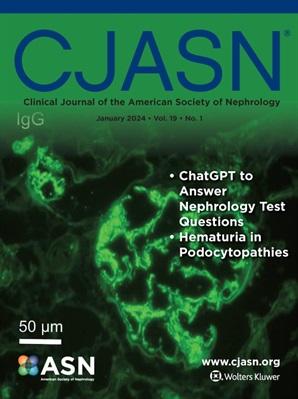Performance of Creatinine and Cystatin-Based Equations on Estimating Measured Glomerular Filtration Rate in People with Hematological and Solid Cancers.
IF 8.5
1区 医学
Q1 UROLOGY & NEPHROLOGY
Clinical Journal of the American Society of Nephrology
Pub Date : 2025-01-28
DOI:10.2215/cjn.0000000616
引用次数: 0
Abstract
BACKGROUND Glomerular filtration rate (GFR) assessment is important in clinical practice, with implications for diagnosis, prognostication, and drug dosing. People with cancer are at risk of imprecision in GFR estimation. This cross-sectional study evaluated the performance of various creatinine and cystatin C-based equations in comparison to measured GFR (mGFR) in people with cancer. METHODS We retrieved data for all adult patients who had mGFR by urinary iothalamate clearance between 2011 and 2023 at Mayo Clinic and use of an electronic health record diagnosis code for cancer within two years prior to mGFR. The Chronic Kidney Disease Epidemiology Collaboration (CKD-EPI), European Kidney Function Consortium (EKFC), and Cockcroft-Gault (CG) equations were computed, along with performance metrics (bias, precision, and root mean square error, RMSE). Confidence intervals were generated by bootstrapping and analysis were stratified by solid and hematological cancer. RESULTS From all adults with cancer and mGFR, 1145 had both creatinine and cystatin C available within seven days of mGFR. Among all equations, the creatinine- cystatin C CKDEPI equation provided the best performance, with small bias (median 3.0, 95%CI 2.3-3.8) and higher precision (RMSE 14.5) compared to creatinine-only or cystatin-only equations (RMSE varying from 16.6 to 20), and this was also true in solid and hematological cancers. The creatinine-cystatin EKFC equation had a similar performance to CKDEPI, CG showed worst precision (30% of people with errors above 30%), and cystatin C CKDEPI equation was the most biased, prone to underestimation of mGFR. CONCLUSIONS In our cohort of patients with mGFR and cancer, the CKDEPI creatinine-cystatin C equation performed best for GFR assessment, and this was true for both solid and hematological cancers. Our findings give support for the preferential use of creatinine and cystatin C-based equations instead of creatinine-only or cystatin C-only equations in people with cancer.血液学和实体癌患者肾小球滤过率估算的肌酐和胱抑素方程的性能。
背景肾小球滤过率(GFR)评估在临床实践中很重要,对诊断、预后和药物剂量都有影响。癌症患者在GFR估计中存在不准确的风险。这项横断面研究评估了各种肌酐和胱抑素c为基础的方程的性能,并与癌症患者测量的GFR (mGFR)进行了比较。方法:我们检索了2011年至2023年在梅奥诊所(Mayo Clinic)通过尿碘甲酸酯清除率和在mGFR发生前两年内使用电子健康记录诊断代码诊断癌症的所有mGFR成年患者的数据。计算慢性肾脏疾病流行病学合作(CKD-EPI)、欧洲肾功能联盟(EKFC)和Cockcroft-Gault (CG)方程,以及性能指标(偏差、精度和均方根误差(RMSE))。置信区间由bootapping生成,分析按实体癌和血液癌分层。结果:在所有患有癌症和mGFR的成年人中,1145人在mGFR后7天内同时具有肌酐和胱抑素C。在所有方程中,肌酸酐-胱抑素C CKDEPI方程提供了最好的性能,与肌酸酐或胱抑素单独方程(RMSE从16.6到20不等)相比,偏差小(中位数为3.0,95%CI为2.3-3.8),精度更高(RMSE为14.5),在实体癌和血流变癌中也是如此。肌酐-胱抑素EKFC方程与CKDEPI具有相似的性能,CG显示出最差的精度(30%的人误差超过30%),而胱抑素C CKDEPI方程偏差最大,容易低估mGFR。结论:在我们的mGFR和癌症患者队列中,CKDEPI肌酐-胱抑素C方程对GFR评估效果最好,对实体癌和血液学癌都是如此。我们的研究结果支持在癌症患者中优先使用肌酐和胱抑素c为基础的方程,而不是仅使用肌酐或仅使用胱抑素c的方程。
本文章由计算机程序翻译,如有差异,请以英文原文为准。
求助全文
约1分钟内获得全文
求助全文
来源期刊
CiteScore
12.20
自引率
3.10%
发文量
514
审稿时长
3-6 weeks
期刊介绍:
The Clinical Journal of the American Society of Nephrology strives to establish itself as the foremost authority in communicating and influencing advances in clinical nephrology by (1) swiftly and effectively disseminating pivotal developments in clinical and translational research in nephrology, encompassing innovations in research methods and care delivery; (2) providing context for these advances in relation to future research directions and patient care; and (3) becoming a key voice on issues with potential implications for the clinical practice of nephrology, particularly within the United States. Original manuscript topics cover a range of areas, including Acid/Base and Electrolyte Disorders, Acute Kidney Injury and ICU Nephrology, Chronic Kidney Disease, Clinical Nephrology, Cystic Kidney Disease, Diabetes and the Kidney, Genetics, Geriatric and Palliative Nephrology, Glomerular and Tubulointerstitial Diseases, Hypertension, Maintenance Dialysis, Mineral Metabolism, Nephrolithiasis, and Transplantation.

 求助内容:
求助内容: 应助结果提醒方式:
应助结果提醒方式:


